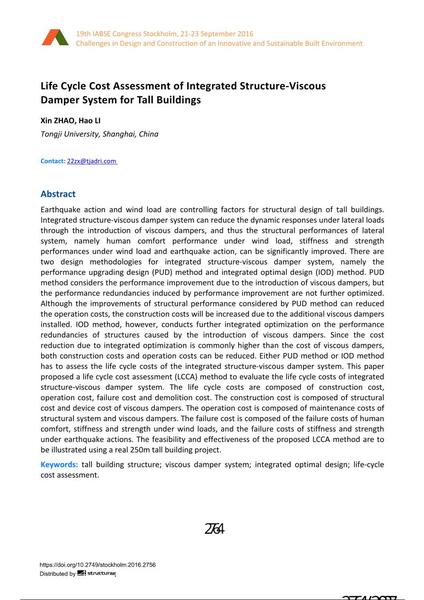Life Cycle Cost Assessment of Integrated Structure-Viscous Damper System for Tall Buildings

|
|
|||||||||||
Bibliographic Details
| Author(s): |
Xin Zhao
(Tongji University, Shanghai, China)
Hao Li (Tongji University, Shanghai, China) |
||||
|---|---|---|---|---|---|
| Medium: | conference paper | ||||
| Language(s): | English | ||||
| Conference: | IABSE Congress: Challenges in Design and Construction of an Innovative and Sustainable Built Environment, Stockholm, Sweden, 21-23 September 2016 | ||||
| Published in: | IABSE Congress Stockholm, 2016 | ||||
|
|||||
| Page(s): | 2764-2770 | ||||
| Total no. of pages: | 7 | ||||
| Year: | 2016 | ||||
| DOI: | 10.2749/stockholm.2016.2756 | ||||
| Abstract: |
Earthquake action and wind load are controlling factors for structural design of tall buildings. Integrated structure-viscous damper system can reduce the dynamic responses under lateral loads through the introduction of viscous dampers, and thus the structural performances of lateral system, namely human comfort performance under wind load, stiffness and strength performances under wind load and earthquake action, can be significantly improved. There are two design methodologies for integrated structure-viscous damper system, namely the performance upgrading design (PUD) method and integrated optimal design (IOD) method. PUD method considers the performance improvement due to the introduction of viscous dampers, but the performance redundancies induced by performance improvement are not further optimized. Although the improvements of structural performance considered by PUD method can reduced the operation costs, the construction costs will be increased due to the additional viscous dampers installed. IOD method, however, conducts further integrated optimization on the performance redundancies of structures caused by the introduction of viscous dampers. Since the cost reduction due to integrated optimization is commonly higher than the cost of viscous dampers, both construction costs and operation costs can be reduced. Either PUD method or IOD method has to assess the life cycle costs of the integrated structure-viscous damper system. This paper proposed a life cycle cost assessment (LCCA) method to evaluate the life cycle costs of integrated structure-viscous damper system. The life cycle costs are composed of construction cost, operation cost, failure cost and demolition cost. The construction cost is composed of structural cost and device cost of viscous dampers. The operation cost is composed of maintenance costs of structural system and viscous dampers. The failure cost is composed of the failure costs of human comfort, stiffness and strength under wind loads, and the failure costs of stiffness and strength under earthquake actions. The feasibility and effectiveness of the proposed LCCA method are to be illustrated using a real 250m tall building project. |
||||
| Keywords: |
tall building structure viscous damper system integrated optimal design life-cycle cost assessment
|
||||
